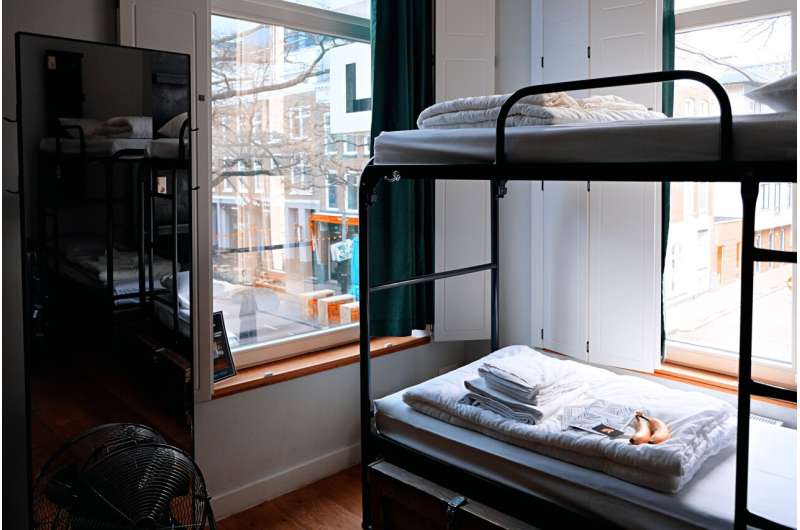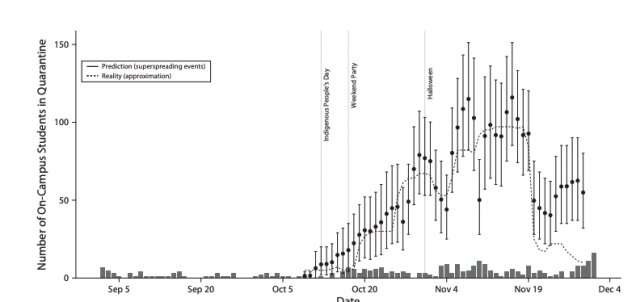Why simple can be better when determining how to allocate pandemic resources

It's difficult to plan ahead when SARS-CoV-2, the virus that causes COVID-19, is so unpredictable. But, there is now a straightforward method for predicting one of the resources needed to slow the spread of COVID-19 in communities. Researchers at Boston University (BU) developed a real-time method for projecting COVID-19 quarantine needs in congregate housing settings ten day in advance.
Eric Kolaczyk, Director of the Hariri Institute and Professor of Mathematics & Statistics, Laura White, Professor of Biostatistics at the BU School of Public Health, and Wenrui Li, a former doctoral student in Mathematics & Statistics, joined forces to create a simple statistical model that incorporates readily available data, including daily case counts and contact tracing details, and is informed by sensible experiences and judgements on human behavior. The team's findings were published recently in The American Journal of Public Health (AJPH).
As was the case for universities across the world, the initial surge of COVID-19 cases that shut down Massachusetts led to some concerns around bringing students back to the BU campus. So during the summer of 2020, BU leadership supporting the COVID-19 response tasked faculty experts with determining the efficacy of testing, contact tracing, and quarantine measures to bring students back safely in the fall. "There was a lot of collaboration across different departments and parts of the university, as well as university leadership that was collecting and storing the data," said White, "This is a really great hallmark of BU's response to COVID in that we made, what has proven to be, a very effective response."

Some of the initial predictions for quarantine and isolation, however, were wrong. Fortunately, BU set aside hundreds more beds than were needed. "We found ourselves in uncharted waters in determining the number of quarantine and isolation beds," said Peter Smokowski, VP of Auxiliary Services, "However, the modeling that Eric's team completed was very helpful in establishing a benchmark number." The researchers' original model was intended to provide guidance for bringing students back to campus safely, rather than specific estimates on the number of beds needed.
Modeling experts Kolaczyk, White, and Li continued working together in the fall to develop a more accurate model for predicting quarantine needs. The team's new model incorporates data on daily positive case counts for students and information from contact tracing on how student populations off and on campus interact. The model also accounts for dates when COVID-19 might spread more quickly, like long weekends or holidays. The methods that the team used to create their model are effective, and quite simple. "The software is only five lines of code," said Kolaczyk, "Yet it is based on a very principled method, based on standard notions of the arrivals of infected individuals and local transmission." Li remains pleasantly surprised by the simplicity and effectiveness of the model. "Our model is simple, but it works well," said Li.
A different SARS-CoV-2 variant or new disease could spring up in the future, and determining how to allocate resources like quarantine housing could make a big difference in how quickly it spreads through congregate settings. The researchers' model can be applied to similar settings where people in close quarters interact with groups outside. Correctional facilities, nursing homes, or military housing locations could use this model to predict quarantine needs and allocate housing resources appropriately. "The driver for us in transitioning this from a BU project to a publication is the realization of how ubiquitous the need for quarantine space optimization is across the world," said Kolaczyk, "Our model can be used as a predictive tool to allocate resources from a relatively milder baseline…rather than being reactive."
More information: Wenrui Li et al, Projecting Quarantine Utilization During a Pandemic, American Journal of Public Health (2022). DOI: 10.2105/AJPH.2021.306573


















